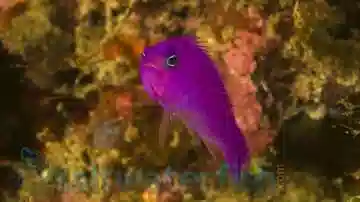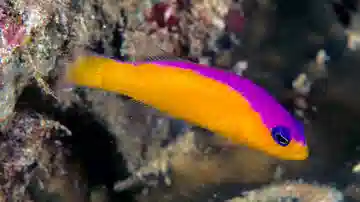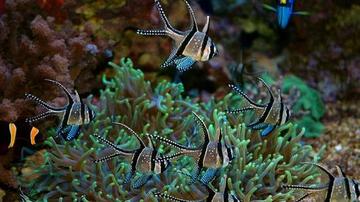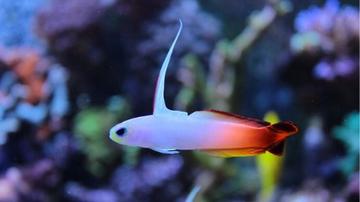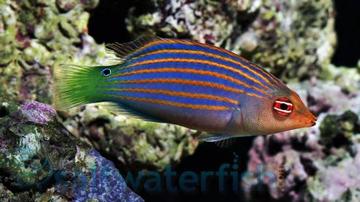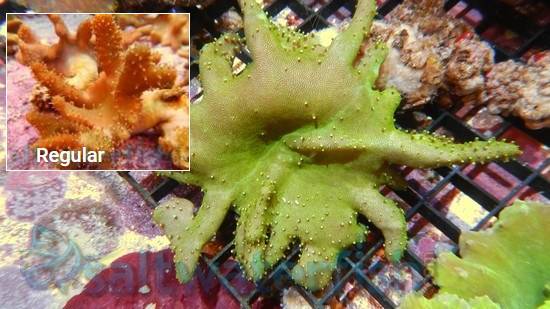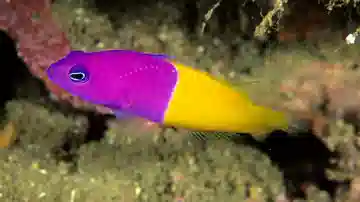Bicolor (Royal) Dottyback
Pictichromis paccagnellae
(15 Reviews)
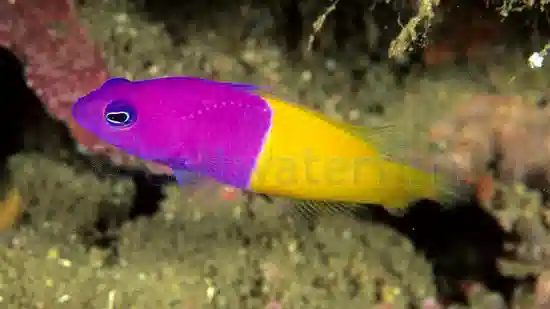
Bicolor (Royal) Dottyback
Pictichromis paccagnellae
(15 Reviews)
{{ item.name }}
Size: {{ item.extra_field_3 }}
${{ getFormattedPrice(item.saleprice) }} ${{ getFormattedPrice(item.price) }}
To join the waiting list, click here
Free Shipping
With
$199.00
or more in Marine Life.
More details...
Bicolor (Royal) Dottyback Care Facts
| Care Level: | Easy |
|---|---|
| Temperament: | Semi-Aggressive |
| Diet: | Carnivore |
| Origin: | Western Pacific Ocean |
| Acclimation Time: | 2+ hours |
| Reef Safe: | Yes |
| Minimum Tank Size: | 30 gallons |
| Max Size: | 3 inches |
The Bicolor Dottyback (Pictichromis paccagnellae), also known as the Royal Dottyback, can be found among the reefs of Eastern Asia. They hide among rock and coral, where they feed on small crustaceans and other invertebrates. They have a vibrant yellow body with a pink streak that covers their face and dorsal section. They reach a maximum size of 3 inches and should be housed in an aquarium with at least 30 gallons. They may be aggressive towards others of the same species or territorial towards tankmates near their burrows. They should be fed carnivorous preparations, such as mysis or krill, and require plenty of live rock to hide in. Lids are recommended, as dottybacks have been known to jump.
Bicolor (Royal) Dottyback (Pictichromis paccagnellae): Making Them Thrive In Your Aquarium
This guide offers essential insights into the husbandry and maintenance of the Bicolor Dottyback in a saltwater marine aquarium. We'll cover various aspects of their care, including their natural habitat, reef compatibility, size, lifespan, dietary requirements in captivity, aquaculture availability, compatibility with other marine species, sexual dimorphism, juvenile to adult coloration changes, temperament, specific tank requirements, and ideal water conditions. We will also explore common names by which this species is known and recommend five compatible tank mates. Additionally, we'll discuss the benefits of choosing Saltwaterfish.com as your source for the Bicolor Dottyback.
Habitat of the Bicolor Dottyback
The Bicolor Dottyback, Pictichromis paccagnellae, is commonly found in the Western Pacific Ocean. They inhabit reef environments, often seeking refuge within the coral branches. When setting up an aquarium for Bicolor Dottybacks, it's crucial to replicate these natural reef conditions, providing them with suitable hiding spots and live rock structures.
Reef Compatibility of the Bicolor Dottyback
The Bicolor Dottyback is considered reef safe, making it a popular choice for reef aquariums. They typically do not harm corals or other invertebrates. However, monitoring their behavior closely is essential, as individual personalities may vary.
Size and Lifespan of the Bicolor Dottyback
Bicolor Dottybacks are relatively small, growing up to 3 inches (7.5 cm) in length. They can live for 5 to 7 years with proper care, offering a lasting addition to your marine aquarium.
Diet in Captivity: What Do Bicolor Dottybacks Eat?
In a captive setting, Bicolor Dottybacks are carnivorous and thrive on a diet of high-quality marine flakes, pellets, and live or frozen foods such as brine shrimp, mysis shrimp, and finely chopped seafood. Providing a varied diet ensures their optimal health and coloration.
Aquaculture and Availability of Bicolor Dottyback
Bicolor Dottybacks are commonly aquacultured and widely available to hobbyists. Opting for aquacultured specimens is an environmentally responsible choice that helps conserve wild populations and supports sustainable practices. When purchasing from a reputable supplier like Saltwaterfish.com, you can be confident that your Bicolor Dottyback is ethically sourced and adapted to aquarium life.
Compatibility with Other Fish and Invertebrates
These dottybacks are known for their aggressive behavior and territorial tendencies, particularly toward other dottybacks or fish of a similar size and coloration. When considering tank mates, larger species are less likely to be perceived as threats. It's best to keep them with peaceful and non-aggressive fish and invertebrates.
Sexual Dimorphism of Bicolor Dottyback
Bicolor Dottybacks typically do not exhibit significant sexual dimorphism. Males and females share similar physical characteristics and coloration.
Juvenile to Adult Coloration Changes of Bicolor Dottyback
Juvenile Bicolor Dottybacks are known for their striking, bright yellow and purple colors. As they mature into adults, these colors may become more subdued, but they remain an eye-catching addition to your aquarium.
Temperament of Bicolor Dottyback
The Bicolor Dottyback is known for its territorial and aggressive nature, mainly when confined to small spaces. Providing them with hiding spots to establish territory is crucial, reducing stress and potential aggression.
Tank Requirements for Bicolor Dottyback
To ensure the well-being of your Bicolor Dottyback, a tank of at least 30 gallons (approximately 114 liters) is recommended. A larger tank provides them with more space and helps reduce territorial behavior. Consistently maintaining water quality is vital. Aim for a pH level of 8.1 to 8.4, a salinity level of 1.020-1.025, and a temperature range of 74-82°F (23-28°C). Adequate water flow and live rock structures are essential to mimic their natural habitat.
Common Names for Bicolor Dottyback
The Bicolor Dottyback is known by the common names Royal Dottyback and Purple Bicolor Dottyback.
Compatible Tank Mates with Bicolor Dottyback
When selecting tank mates for your Bicolor Dottyback, consider these five suitable options:
- Clownfish (Amphiprion species)
- Firefish Goby (Nemateleotris species)
- Pajama Cardinalfish (Sphaeramia nematoptera)
- Banggai Cardinalfish (Pterapogon kauderni)
- Flame Angelfish (Centropyge loricula)
Why Choose Bicolor Dottyback from Saltwaterfish.com
Choosing the Bicolor Dottyback from a reputable supplier like Saltwaterfish.com ensures you receive healthy and acclimated fish. Saltwaterfish.com is dedicated to ethical and sustainable practices, making it a reliable source for marine enthusiasts.
In conclusion, the Bicolor Dottyback, with its striking appearance and unique temperament, is a captivating addition to your saltwater marine aquarium. By providing proper care, a balanced diet, and a suitable tank setup, you can enjoy their vibrant presence for years to come.
Reviewed by: Jana Hess on March 10, 2025
Reviewed by: Harvey Pinkerton on March 4, 2025
Beautiful colors
Reviewed by: Debbie Cook on Feb. 23, 2025
Reviewed by: Waldes Perez on Feb. 6, 2025
Very similar to the Royal Gramma but at a lesser price and just as beautiful colors. Very friendly fish. Keeps to himself and adds a colorful appeal to the tank.
Reviewed by: Dale Pichelmayer on July 29, 2024
Reviewed by: Gary Sparks on June 3, 2024
Nice addition to my tank
Reviewed by: Richard Kenney on May 6, 2024
Beautiful fish
Reviewed by: Maria Robles on April 28, 2024
Reviewed by: Corey Faithfull on Feb. 7, 2024
I liked my royal gramma so much I had to get this royal dottyback for my other tank just to look at the great color they both present in the tank. This one is very shy and basically keeps to himself until it’s time to eat then he’s not shy at all. If you don’t already have one, now’s a good time to get one.
Reviewed by: Dale Pichelmayer on Jan. 29, 2024
Colors are just as vibrant as the picture if not more vibrant in certain lighting. Is very active and a great community fish for a smaller reef tank.
Reviewed by: Meghan Devine on Jan. 24, 2024
Reviewed by: Mike Connolly on Nov. 27, 2023
Beautiful
Reviewed by: Gail Cormier on Aug. 29, 2023
Reviewed by: Darryl Killingsworth on July 25, 2023
So pretty love the colors
Reviewed by: Kim Smith on July 24, 2023


